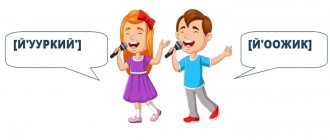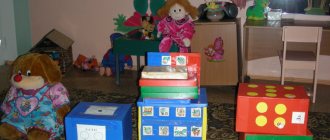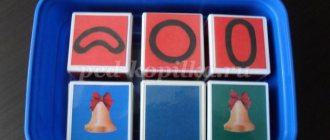Explanatory note
In the elementary grades, some children may experience difficulties in mastering written language, such as missing letters, replacing them, or distorting the spelling of words. This usually occurs with organic speech disorders. If these violations are identified in a timely manner and corrective training is carried out, it is possible to prevent their transition, which complicates the educational and cognitive activity of students at subsequent stages.
This program is designed to work with students in grades 1-4 to prevent dysgraphia.
Scientific validity
When compiling this program, I relied on the methodological developments and scientific research of V. A. Kovshikov, R. I. Lalaev, L. N. Misarenko, G. M. Sumchenko, Yu. G. Demyanova, V. V. Konovalenko, I. I. Sadovnikova, I. E. Tokar. The work program was developed on the basis of O. V. Chistyakova’s manual on the prevention of dysgraphia in grades 1-4. The following methodological developments were also used to compile the program
1. Eletsky O.V., Gorbachevskaya N.Yu., Organization of speech therapy work at school: M.: 2001.
2. Efimenkova L.N., Misarenko G.G., Organization and methods of correctional work of a speech therapist at a school speech center: A manual for speech therapists. – M.: 1991.
3. Gaidina L.N., Obukhova L.A., Speech therapy exercises, correction of written speech disorders. – M.: 2008.
4. Tokar I. E. Collection of exercises for the prevention and elimination of written speech disorders among students in grades 2-4 of secondary schools. – M.: 2005.
5. Mazanova E. V. Method of recommendation by a speech therapist teacher of school speech centers for the organization of correctional work. – M.: 2005.
Goal of the program: correction of written language disorders in students in grades 1-4
Tasks:
— development of phonemic analysis and synthesis;
- formation and development of grammatically correct speech;
— development of memory, attention, spatial perception, observation;
— expansion of vocabulary;
- development of coherent speech.
1.Contents
This program is intended for speech therapy work with students from grades 1 to 4 who have difficulties in developing written speech. All material presented in the program is designed for 4 years of study and is compiled taking into account the age characteristics of students.
1st grade has 20 hours. All correctional work in 1st grade can be divided into 3 sections :
— Section 1 includes tasks aimed at developing memory, attention, spatial perception, and observation skills;
— section 2 includes theoretical information on the Russian language, tasks for the development of sound perception, distinguishing sounds and letters, work on words and sentences;
— section 3 includes tasks and games aimed at expanding the vocabulary, developing the child’s coherent speech, as well as exercises designed to solve the problem of missing letters.
Duration of classes is 20-25 minutes.
Basic requirements for knowledge and skills by the end of 1st grade:
Students should know:
sentence construction; the main difference between a sound and a letter; sound-letter analysis and synthesis of words, syllabic analysis of words.
Students should be able to:
- isolate sounds from words and pronounce them correctly;
- distinguish vowel sounds and letters from consonants;
- recognize and differentiate paired, sonorant, whistling and hissing consonant sounds and letters;
- indicate in writing the softness of consonant sounds with the vowels e, e, i, yu, i;
- divide words into syllables;
- highlight the stressed syllable in a word;
- write sentences correctly - use a capital letter at the beginning, a period at the end of the sentence;
- retell simple sentences.
In grade 2, correctional work lasts 30 hours. The work is carried out to consolidate topics related to the study of parts of speech and the composition of words, some of the classes are aimed at expanding vocabulary and the formation of coherent speech. Duration of classes is 25-35 minutes.
Basic requirements for knowledge and skills by the end of 2nd grade:
Students should know:
Studied parts of speech and their characteristics; morphological composition of the word.
Students should be able to:
- actively use various methods of word formation;
- have the skills to master the morphological composition of a word;
- master phrases, connections between words in a sentence;
- write prepositions and words separately;
- write sentences correctly: use a capital letter at the beginning of a sentence, put a period, an exclamation point and a question mark at the end of a sentence.
In grades 3-4, correctional work lasts 30 hours. Correctional work is devoted to consolidating the topics: “Related words”, “Formation of words”, “Unstressed vowels in the root of a word, stress checked”, as well as exercises for distinguishing vowels and consonants sounds (letters), which can be mixed in the child’s oral and written speech. Lesson duration is 25-35 minutes.
Basic requirements for knowledge and skills by the end of grades 3-4:
Students should know:
Syllable analysis of a word; softness of consonants; morphological composition of the word: root, ending, prefix, suffix; sentences: narrative, interrogative, exclamatory.
Students should be able to:
- perform sound-letter analysis of words;
- establish relationships between letters and sounds in a word;
- use different methods of word formation;
- possess the primary skills of mastering the morphological composition of a word;
- use various sentence structures in speech;
— build a coherent statement, establish logic (coherence, consistency);
— accurately and clearly formulate thoughts in the process of preparing a coherent statement;
- draw up a text plan.
Recommendations for conducting classes
1. The child needs a manual from O. V. Chistyakova, a simple pencil, a pen, colored pencils, a notebook.
2. During classes, try to avoid negative assessments when your child fails. On the contrary, once again praise him for what he does.
3. If the task turns out to be too difficult, you can put it off for a while and then return to it.
4. You can return to the same task several times, changing the material for work (other sounds, words, pictures, sentences).
5. At the end of each lesson, the child is asked to evaluate his work. If he thinks that he has worked hard and completed all the tasks, then he paints over the green circle of the traffic light; if there were difficulties - a yellow circle, if most of the tasks were completed poorly - a red circle. An adult can also evaluate the child’s work by coloring the corresponding circle of the second traffic light.
7. Remember that you need to study constantly until errors of this kind disappear in your child’s written work.
The program can be supplemented and changed as you work with it.
Calendar-thematic plan of work to prevent dysgraphia
1 class
| No. | Lesson topic | Number of hours | date | |
| According to plan | actually | |||
| 1. | Sounds and letters. | 1 | ||
| 2. | Sounds and letters. | 1 | ||
| 3. | Sounds and letters. | 1 | ||
| 4. | Consonant sounds and letters. | 1 | ||
| 5. | Consonant sounds and letters. | 1 | ||
| 6. | Indication of softness and hardness of consonants using vowels. | 1 | ||
| 7. | Distinguishing letters a-z. | 1 | ||
| 8. | Distinguishing letters o-e. | 1 | ||
| 9. | Distinguishing letters u-yu. | 1 | ||
| 10. | Letters e, e, yu, i. | 1 | ||
| 11. | Letters e, e, yu, i. | 1 | ||
| 12. | Letters e, e, yu, i | 1 | ||
| 13. | Dividing words into syllables. | 1 | ||
| 14. | Dividing words into syllables. | 1 | ||
| 15. | Dividing words into syllables. Emphasis. | 1 | ||
| 16. | Emphasis. Hyphenation. | 1 | ||
| 17. | Words-objects, words-signs, words-actions. | 1 | ||
| 18. | Words-objects, words-signs, words-actions. | 1 | ||
| 19. | Offer. | 1 | ||
| 20. | Offer. | 1 | ||
Calendar-thematic plan of work to prevent dysgraphia
2nd grade
| No. | Lesson topic | Number of hours | date | ||
| According to plan | Actually | ||||
| 1. | Noun. General meaning. | 1 | |||
| 2. | Noun. Gender and number. | 1 | |||
| 3. | Verb. General meaning. | 1 | |||
| 4. | Verb. Date and time. | 1 | |||
| 5. | Distinguishing between a noun and a verb. | 1 | |||
| 6. | Adjective name. General meaning. | 1 | |||
| 7. | Adjective. Number and gender. | 1 | |||
| 8. | Distinguish between nouns, adjectives and verbs. | 1 | |||
| 9. | Pretext. | 1 | |||
| 10. | Pretext. | 1 | |||
| 11. | Words that are close in meaning (synonyms). | 1 | |||
| 12. | Words with opposite meanings (antonyms). | 1 | |||
| 13. | Words that have the same spelling and pronunciation (homonyms). | 1 | |||
| 14. | Single and polysemous words. | 1 | |||
| 15. | Phraseologisms. | 1 | |||
| 16. | Composition of the word. Root. Related words and word forms. | 1 | |||
| 17. | Composition of the word. Root. Related words and word forms. | 1 | |||
| 18. | Composition of the word. Root. Related words and word forms. | 1 | |||
| 19. | Composition of the word. Console. | 1 | |||
| 20. | Prefix and preposition. | 1 | |||
| 21. | Composition of the word. Suffix. | 1 | |||
| 22. | Composition of the word. Morphemic analysis. | 1 | |||
| 23. | Offer. | 1 | |||
| 24. | Offer. The grammatical basis of the sentence. | 1 | |||
| 25. | Offer. Agreement of the verb with the noun in number and gender. | 1 | |||
| 26. | Offer. Agreement of the verb with the noun in number and gender. | 1 | |||
| 27. | Offer. Control. | 1 | |||
| 28. | Proposal distribution. | 1 | |||
| 29. | Boundaries of the proposal. | 1 | |||
| 30. | Connection of words in a sentence. | 1 | |||
Calendar-thematic plan of work to prevent dysgraphia
3-4 grade
| No. | Lesson topic | Number of hours | date | ||
| According to plan | Actually | ||||
| 1. | Related words. | 1 | |||
| 2. | Composition of the word. Forming words using prefixes. | 1 | |||
| 3. | Composition of the word. Forming words using suffixes. | 1 | |||
| 4. | Emphasis. | 1 | |||
| 5. | Unstressed vowels in the root of a word, checked by stress. | 1 | |||
| 6. | Unstressed vowels in the root of a word, checked by stress. | 1 | |||
| 7. | Distinguishing letters o-a. | 1 | |||
| 8. | Distinguishing letters i-u. | 1 | |||
| 9. | Distinguishing letters i-s. | 1 | |||
| 10. | Distinguishing letters ё-yu. | 1 | |||
| 11. | Distinguishing letters b-p. | 1 | |||
| 12. | Distinguishing letters v-f. | 1 | |||
| 13. | Distinguishing letters g-k. | 1 | |||
| 14. | Distinguishing letters d-t. | 1 | |||
| 15. | Distinguishing letters zh-sh. | 1 | |||
| 16. | Distinguishing letters z-s. | 1 | |||
| 17. | Distinguishing letters l-m. | 1 | |||
| 18. | Distinguishing letters k-n. | 1 | |||
| 19. | Distinguishing letters p-t. | 1 | |||
| 20. | Distinguishing letters b-d. | 1 | |||
| 21. | Distinguishing letters x-zh. | 1 | |||
| 22. | Distinguishing letters sh-sch. | 1 | |||
| 23. | Distinguishing letters n-p. | 1 | |||
| 24. | Distinguishing the letters f-x. | 1 | |||
| 25. | Distinguishing letters s-sh. | 1 | |||
| 26. | Distinguishing letters z-zh. | 1 | |||
| 27. | Distinguishing letters h-sch. | 1 | |||
| 28. | Distinguishing the letters ch-sh. | 1 | |||
| 29. | Distinguishing letters h-ts. | 1 | |||
| 30. | Distinguishing letters s-ts. | 1 | |||





